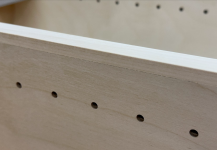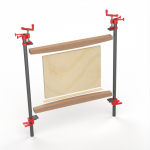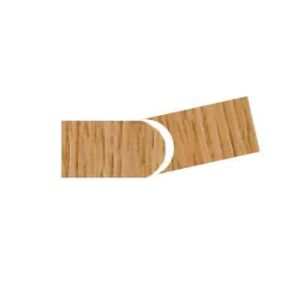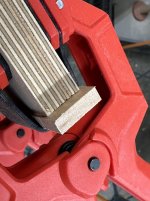ryanjg117
Member
- Joined
- May 18, 2015
- Messages
- 328
I'm partial to birch or maple plywood with hardwood edging. I've got a nice thin rip jig for the cabinet saw and it's quite easy to pound out 1/8" or 1/4" thick hardwood veneers for edge banding.
However, I often find my glue-ups leave a bit to be desired. Here's a nice visual encapsulation of my problem:
[attachimg=1]
I think this really boils down to not applying adequate clamping pressure uniformly across the edge. I've made some cauls and do get the best results when I use two big parallel clamps at either side, like depicted below:
[attachimg=2]
But sometimes it's not possible to do this - for example, when applying edge banding on a finished cabinet carcass. In the future, I'm going to try to remember to always apply edging before I assemble the cabinet...
In the situation above, the cabinet was already built, and I used about 15 Large Spring Molding Edge Band Clamps 8" Long for Banding up to 1-1/2" Thick. I've also experimented with 3M Binding Tape. Neither is really strong enough to close up that gap.
So, I'm curious - given that my clamping options can't be improved, is there a better glue option to use here? Perhaps one that dries exactly the same color as the wood? I've experimented with Better Bond X-Press in Light Color and that does seem to hold well, though it's not recommended for super-thick veneering like what I'm trying to do here.
Given that I'm already in a pickle, do you think there's a way to improve this? I could try chasing the seam with a Bahco carbide 3-point scraper and fill it with some Mohawk Fil-Stik that is perfectly color matched, but I'm a little nervous to use a wax product before finishing. (These will be sprayed with a clear, semi-gloss poly finish).
However, I often find my glue-ups leave a bit to be desired. Here's a nice visual encapsulation of my problem:
[attachimg=1]
I think this really boils down to not applying adequate clamping pressure uniformly across the edge. I've made some cauls and do get the best results when I use two big parallel clamps at either side, like depicted below:
[attachimg=2]
But sometimes it's not possible to do this - for example, when applying edge banding on a finished cabinet carcass. In the future, I'm going to try to remember to always apply edging before I assemble the cabinet...
In the situation above, the cabinet was already built, and I used about 15 Large Spring Molding Edge Band Clamps 8" Long for Banding up to 1-1/2" Thick. I've also experimented with 3M Binding Tape. Neither is really strong enough to close up that gap.
So, I'm curious - given that my clamping options can't be improved, is there a better glue option to use here? Perhaps one that dries exactly the same color as the wood? I've experimented with Better Bond X-Press in Light Color and that does seem to hold well, though it's not recommended for super-thick veneering like what I'm trying to do here.
Given that I'm already in a pickle, do you think there's a way to improve this? I could try chasing the seam with a Bahco carbide 3-point scraper and fill it with some Mohawk Fil-Stik that is perfectly color matched, but I'm a little nervous to use a wax product before finishing. (These will be sprayed with a clear, semi-gloss poly finish).





